Researchers at the University of Twente in the Netherlands have gained important insights into photons, the elementary particles that make up light. They “behave” in a surprisingly greater variety than the electrons that surround atoms, but they are also much easier to control.
Photons: the elementary particles that make up light
These new insights have broad applications from smart LED lighting to novel photonic information bits controlled by quantum circuits to sensitive nanosensors. Their findings have been published in Physical Review B.
In atoms, tiny elementary particles called electrons occupy regions around the nucleus in shapes called orbitals. These orbitals give the probability of finding an electron in a particular region of space. Quantum mechanics determines the shape and energy of these orbitals. Similar to electrons, researchers also describe the region of space where a photon is most likely to be found with orbitals.
Researchers at the University of Twente have studied these photonic orbitals and found that with careful design of specific materials, they can create and control these orbitals with a wide variety of shapes and symmetries. These findings have potential applications in advanced optical technologies and quantum computing.
First author Kozon explains: “In textbook chemistry, electrons always orbit the small atomic nucleus at the center of the orbital. So the shape of an electron orbital can’t deviate much from a perfect sphere. With the photon, orbitals can have any wild shape you design by combining different optical materials in designed spatial arrangements.”

The researchers conducted a computational study to understand how the photon behaves when confined in a specific 3D nanostructure composed of tiny pores (a photonic crystal). These cavities are intentionally designed to have defects, creating a superstructure that isolates the photonic states from their surroundings.
Physicists Vos and Lagendijk say: “Given the rich toolbox of nanotechnology, it is much easier to design ingenious nanostructures with new photon orbitals than to modify atoms to make new electronic orbitals and new chemistry.”
Photonic orbitals are important for the development of advanced optical technologies, such as efficient lighting, quantum computing, and sensitive photonic sensors. Researchers have also studied how these nanostructures enhance the local density of optical states, which is important for applications in cavity quantum electrodynamics.
They found that structures with smaller defects showed greater enhancement than those with larger defects, making them more suitable for integrating quantum dots and creating single-photon networks.
New Device Precisely Controls Photon Emissions for More Efficient Portable Displays
Recently, a team of chemists, mathematicians, physicists, and nanoengineers at the University of Twente in the Netherlands developed a device to control the emission of photons with unprecedented precision. This technology could lead to more efficient miniature light sources, sensitive sensors, and stable quantum bits for quantum computing.
The part of yours smartphone that consumes the most energy is the screen. Reducing any unwanted energy that leaks from the screen increases the lifespan of our smartphone. Imagine that your smartphone only needs to be charged once a week. However, to increase efficiency, you need to be able to emit photons in a more controlled manner.
The researchers developed the “MINT-toolbox”: a set of tools from the scientific disciplines of mathematics, computer science, natural sciences and technology. In this toolbox, there were advanced chemical tools. The most important were polymer brushes, small chemical chains that can hold photon sources in a certain place.

First author Andreas Schulz explains: “The polymer brushes are grafted in solution from porous surfaces inside a so-called photonic crystal made of silicon. A rather complicated experiment. So we were very excited when we saw in separate X-ray imaging studies that the photon sources were positioned in the right positions on the top of the brushes.”
By adding nanophotonic tools, the team showed that excited light sources are inhibited by almost 50 times. In this situation, a light source remains excited 50 times longer than usual. The spectrum corresponds very well to the theoretical one calculated with advanced mathematical tools. Second author Marek Kozoň says: “The theory predicts zero light since it concerns an infinitely extended fictitious crystal. In our real finite crystal, the emitted light is non-zero, but so small that it is a new world record.”
The new results promise a new era for efficient lasers and miniature light sources, for qubits in photonic circuits with strongly reduced perturbations (due to elusive vacuum fluctuations). Willem Vos says: “Our multi-toolbox offers opportunities for completely new applications that profit from strongly stabilized excited states. These are fundamental for photochemistry and could become sensitive chemical nanosensors.”
Many photons are better than one for advancing quantum technologies
Quantum objects, such as electrons and photons, behave differently from other objects in ways that enable quantum technology. Therein lies the key to unlocking the mystery of quantum entanglement, in which multiple photons exist in multiple modes or frequencies.
In the pursuit of photonic quantum technologies, previous studies have established the utility of Fock states. These are multiphoton, multimodal states made possible by cleverly combining a number of single-photon inputs using so-called linear optics. However, some essential and valuable quantum states require more than this photon-by-photon approach.
Now, a team of researchers from Kyoto University and Hiroshima University has theoretically and experimentally confirmed the unique advantages of non-Fock states, or iNFSs, complex quantum states that require more than a single photon source and linear optical elements. The study was published in the journal Science Advances.
“We successfully confirmed the existence of the iNFS using a multi-photon optical quantum circuit,” says corresponding author Shigeki Takeuchi at the Graduate School of Engineering.

“Our study will lead to breakthroughs in applications such as optical quantum computers and optical quantum sensing,” adds co-author Geobae Park.
The photon is a promising carrier because it can be transmitted over long distances while preserving its quantum state at constant room temperature. Exploiting many photons in multiple modes would realize long-distance optical quantum cryptography, optical quantum sensing, and optical quantum computing.
“We have painstakingly generated a complex type of iNFS by using our Fourier transform photonic quantum circuit to manifest two photons in three different paths, which is the most difficult conditional coherence phenomenon to achieve,” explains co-author Ryo Okamoto.
Furthermore, this study compared another phenomenon with the widely used quantum entanglement, which appears and disappears simply by passing through a single linear optical element. Quantum entanglement is a quantum state with two or more states entangled in a superposition between two separate systems.
“Remarkably, this study shows that the properties of the iNFS do not change when it passes through a network of many linear optical elements, marking a leap forward in quantum optical technology,” notes co-author Holger F Hofmann of Hiroshima University.
Takeuchi’s team hypothesizes that the iNFS exhibits conditional coherence, a rather mysterious phenomenon in which the detection of even a single photon implies that the remaining photons exist in a superposition of multiple paths.
“Our next step will be to realize large-scale multi-mode, multi-photon, and quantum optical circuit chips,” Takeuchi announces.
#Forms #Photons #Open #Door #Advanced #Optical #Technologies